Creating positive customer retention strategies
Is your organization deploying positive customer retention strategies or negative ones? In this chapter excerpt, learn about a number of positive customer retention strategies, including how to add customer-perceived value, create social and structural bonds and build engagement to delight your customers.
Customer Relationship Management, Second Edition
Chapter 9, Managing the customer lifecycle: Customer retention and development
 |
|
Is your organization deploying positive customer retention strategies or negative ones? In this chapter excerpt, learn about a number of positive customer retention strategies, including how to add customer-perceived value, create social and structural bonds and build engagement to delight your customers.

Customer Relationship Management, Chapter 9
Table of contents:
![]() Customer retention management
Customer retention management
![]() Customer retention vs. value retention
Customer retention vs. value retention
![]() Creating positive customer retention strategies
Creating positive customer retention strategies
![]() Understanding customer commitment
Understanding customer commitment
![]() Customer development and termination strategies
Customer development and termination strategies

Strategies for customer retention
Positive and negative retention strategies
An important distinction can be made between strategies that lock the customer in by penalizing their exit from a relationship, and strategies that reward a customer for remaining in a relationship. The former are generally considered negative, and the latter positive, customer retention strategies. Negative customer retention strategies impose high switching costs on customers, discouraging their defection.
|
||||
In a B2C context, mortgage companies have commonly recruited new customers with attractive discounted interest rates. When the honeymoon period is over, these customers may want to switch to another provider, only to discover that they will be hit with early redemption and exit penalties. Customers wishing to switch retail banks fi nd that it is less simple than anticipated: direct debits and standing orders have to be reorganized. In a B2B context, a customer may have agreed a deal to purchase a given volume of raw material at a quoted price. Some way through the contract a lower cost supplier makes a better offer. The customer wants to switch, but fi nds that there are penalty clauses in the contract. The new supplier is unwilling to buy the customer out of the contract by paying the penalties.
Some customers find these switching costs are so high that they remain customers, though unwillingly. The danger for CRM practitioners is that negative customer retention strategies produce customers who feel trapped. They are likely to agitate to be freed from their obligations, taking up much management time. Also, they may utter negative word-of- mouth. They are unlikely to do further business with that supplier. Companies that pursue these strategies argue that customers need to be aware of what they are buying and the contracts they sign. The total cost of ownership (TCO) of a mortgage should, and does, include early redemption costs.
When presented with dissatisfied customers complaining about high relationship exit (switching) costs, companies have a choice. They can either enforce the terms and conditions, or not. The latter path is more attractive when the customer is strategically significant, particularly if the company can make an offer that matches that of the prospective new supplier.
Positive customer retention strategies
In the following sections we look at a number of positive customer retention strategies, including creating customer delight, adding customer-perceived value, creating social and structural bonds and building customer engagement.
Customer delight
It is very difficult to build long-term relationships with customers if their needs and expectations are not understood and well met. It is a fundamental precept of modern customer management that companies should understand customers, and then acquire and deploy resources to ensure their satisfaction and retention. This is why CRM is grounded on detailed customer-related knowledge. Customers that you are not able to serve well may be better served by your competitors.
Delighting customers, or exceeding customer expectations, means going beyond what would normally satisfy the customer. This does not necessarily mean being world-class or best-in-class. It does mean being aware of what it usually takes to satisfy the customer and what it might take to delight or pleasantly surprise the customer. You cannot really strategize to delight the customer if you do not understand the customer's fundamental expectations. You may stumble onto attributes of your performance that do delight the customer, but you cannot consistently expect to do so unless you have deep customer insight. Consistent efforts to delight customers show your commitment to the relationship. Commitment builds trust. Trust begets relationship longevity.
Customer delight occurs when the customer's perception of their experience of doing business with you exceeds their expectation. In formulaic terms:
CD = P > E
where CD = customer delight, P = perception and E = expectation.
This formula implies that customer delight can be influenced in two ways: by managing expectations or by managing performance. In most commercial contexts customer expectations exceed customer perceptions of performance. In other words, customers can generally find cause for dissatisfaction. You might think that this would encourage companies to attempt to manage customer expectations down to levels that can be delivered. However, competitors may well be improving their performance in an attempt to meet customer expectations. If your strategy is to manage expectations down, you may well lose customers to the better performing company. This is particularly likely if you fail to meet customer expectations on important attributes.
Customers have expectations of many attributes, for example product quality, service responsiveness, price stability and the physical appearance of your people and vehicles. These are unlikely to be equally important. It is critical to meet customer expectations on attributes that are important to the customer. Online customers, for example, look for rapid and accurate order fulfilment, good price, high levels of customer service and website functionality. Online retailers must meet these basic requirements. Dell Computers believes that customer retention is the outcome of their performance against three variables: order fulfi lment (on-time, in full, no error (OTIFNE)), product performance (frequency of problems encountered by customers) and after-sales service (percentage of problems fixed first time by technicians). The comments in parentheses are the metrics that Dell uses.
Figure 9.1 identifies a number of priorities for improvement (PFIs) for a restaurant company. The PFIs are the attributes where customer satisfaction scores are low, but the attributes are important to customers. In the example, the PFIs are food quality and toilet cleanliness. There would be no advantage in investing in speedier service or more helpful staff.
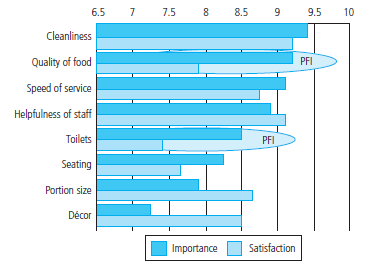
Figure 9.1: Using customer satisfaction and importance data to identify priorities for improvement.
Kano's customer delight model
Noriaki Kano has developed a product quality model that distinguishes between three forms of quality. Basic qualities are those that the customer routinely expects in the product. These expectations are often unexpressed until the product fails. For example, a car's engine should start first time every time, and the sunroof should not leak. The second form is linear quality. These are attributes of which the customer wants more or less; for example, better comfort, better fuel economy and reduced noise levels. Marketing research can usually identify these requirements. Better performance on these attributes generates better customer satisfaction. The third form is attractive quality. These are attributes that surprise, delight and excite customers. They are answers to latent, unarticulated, needs and are often difficult to identify in marketing research. As shown in Figure 9.2 , Kano's analysis suggests that customers can be delighted in two ways: by enhancing linear qualities beyond expectations and by creating innovative attractive qualities.
Exceeding expectations need not be costly. For example, a sales representative could do a number of simple things such as:
- Volunteer to collect and replace a faulty product from a customer rather than issuing a credit note and waiting for the normal call cycle to schedule a call on the customer.
- Offer better, lower cost solutions to the customer, even though that might reduce profit margin.
- Provide information about the customer's served market. A packaging company, for example, might alert a fast-moving consumer goods manufacturer customer to competitive initiatives in their served markets.
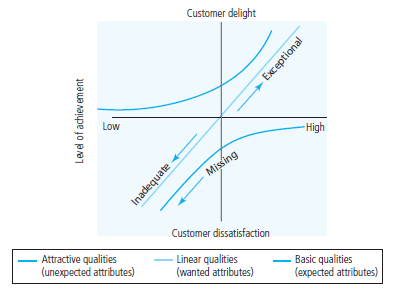
Figure 9.2: Customer delight through product quality. Source: Kano 1995
Some efforts to delight customers can go wrong. For example, sooner is not necessarily better: if a retail store customer has requested delivery between 1 pm and 3 pm, and the driver arrives an hour early, the truck may clog up goods inwards and interfere with a carefully scheduled unload plan. Many contact centres play music while callers are waiting online. This is to divert the caller's attention and to create the illusion of faster passage of time. However, the cycle time of the selected music must not be too fast, otherwise callers will be exposed to the same songs repeatedly. Also, the music needs to be appropriate to the context. Customers may not appreciate ' (I Can't Get No) Satisfaction ' by the Rolling Stones if they are waiting online to complain.
A number of companies have adopted ' Customer Delight' as their mission, including Cisco, American Express and Kwik Fit, the auto service chain. Others pay homage to the goal but do not organize to achieve it. In the service industries, customer delight requires frontline employees to be trained, empowered and rewarded for doing what it takes to delight customers. It is in the interaction with customers that contact employees have the opportunity to understand and exceed their expectations. The service quality attributes of empathy and responsiveness are on show when employees successfully delight customers.
Companies sometimes complain that investing in customer delight is unproductive. As noted earlier, expectations generally increase as competitors strive to offer better value to customers. Over time, as customers experience delight, their expectations change. What was exceptional becomes the norm. In Kano's terms, what used to be an attractive attribute becomes a linear or basic attribute. It no longer delights. Delight decays into normal expectation, and companies have to look for new ways to pleasantly surprise customers. In a competitive environment, it seems to make little sense to resist the quest for customer delight because competitors will simply drive up expectations anyway.
Add customer-perceived value
The second major positive customer retention strategy is to add customer-perceived value. Companies can explore ways to create additional value for customers. The ideal is to add value for customers without creating additional costs for the company. If costs are incurred then the value-adds may be expected to recover those costs. For example, a customer club may be expected to generate a revenue stream from its membership.
There are three common forms of value-adding programme: loyalty schemes, customer clubs and sales promotions.
Loyalty schemes
Loyalty schemes reward customers for their patronage. Loyalty schemes or programmes can be defined as follows:
A loyalty programme is a scheme that offers delayed or immediate incremental rewards to customers for their cumulative patronage. The more a customer spends, the higher the reward. Loyalty schemes have a long history. In 1844, in the UK, the Rochdale Pioneers developed a cooperative retailing operation that distributed surpluses back to members in the form of a dividend. The surpluses were proportionate to customer spend. S & H Pink Stamps and Green Shield stamps were collected in the 1950s and 1960s, and redeemed for gifts selected from catalogues. In the 1970s, Southwest Airlines ran a ' Sweetheart Stamps ' programme that enabled travellers to collect proofs of purchase and surrender them for a free fl ight for their partner.
Today's CRM-enabled loyalty schemes owe their structure to the frequent flier programmes (FFP) that started with American Airlines ' Advantage programme in 1981. The airline made a strategic decision to use its spare capacity as a resource to generate customer loyalty. Airlines are high fixed-cost businesses. Costs do not change much, regardless of whether the load factor is 25 percent or 95 percent. American knew that filling the empty seats would have little impact on costs, but could impact significantly on future demand. The airline searched its reservation system, SABRE, for details of frequent fliers in order to offer them the reward of free flights.
This basic model has migrated from airlines into many other B2C sectors: hotels, restaurants, retail, car hire, gas stations and bookstores, for example. It has also transferred into B2B contexts with many suppliers offering loyalty rewards to long-term customers.
The mechanics of these schemes have changed over time. Initially, stamps were collected. The first card-based schemes were anonymous, i.e. they carried no personal data, not even the name of the participant. Then magnetic stripe cards were introduced, followed by chip-embedded cards that carried a lot of personal and transactional data. Innovators developed their own individual schemes. Eventually, these transformed into linked schemes, in which, for example, it was possible to collect air miles from various participating companies such as gas stations, credit cards and food retailers. Current schemes are massively different from the early programmes. For example, Nectar is a consortium loyalty scheme operating in the UK managed not by the participants, but by an independent third party. Its core retail participants are all number one or two in their respective markets: Sainsbury's, Barclaycard, Debenhams and BP. Shoppers register with the scheme, then carry a single magnetic stripe card and collect points that are converted into vouchers redeemable in a wide range of retailers, including supermarkets, liquor stores, catalogue retailers, restaurants, hotels, cinemas, travel outlets and tourist attractions. Each of the major retail participants had been a member of another loyalty programme, and customers were able to convert their existing credits to Nectar points (see Figure 9.3 ).
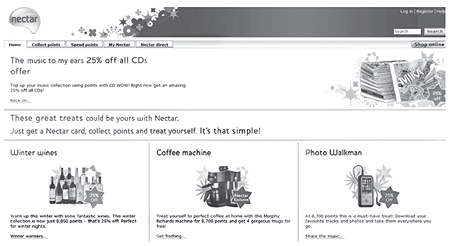
Figure 9.3: Nectar loyalty program
Loyalty programmes provide added value to consumers at two points, during credit acquisition and at redemption. Although the credits have no material value until they are redeemed, they may deliver some pre-redemption psychological benefits to customers, such as a sense of belonging and of being valued, and an enjoyable anticipation of desirable future events. At the redemption stage, customers receive both psychological and material benefits. The reward acts to positively reinforce purchase behavior. It also demonstrates that the company appreciates its customers. This sense of being recognized as valued and important can enhance customers ' overall sense of well-being and emotional attachment to the firm. However, customers can become loyal to the scheme, rather than to the company or brand behind the scheme.
Loyalty schemes are not without critics. Critics question their cost and effectiveness. Certainly, they can be very expensive to establish and manage. In respect of operating costs, retail schemes typically reward customers with a cash rebate or vouchers equivalent to 1 percent of purchases. This comes straight out of the bottom line so a retailer that is making 5 percent margin loses one-fifth or 20 percent of its profit to fund the scheme. There may also be a significant investment in technology to support the scheme, and marketing to launch and sustain the scheme. Supermarket operator Safeway dropped its UK loyalty programme, which had been costing about £30 million annually. Shell is reported to have spent up to £40 million to develop its smart card scheme. Unredeemed credits represent liabilities for scheme operators. For example, it has been suggested that if all the unused air miles were redeemed on the same day it would take 600,000 Boeing 747s to meet the demand.
Schemes are also criticized for their effectiveness. Critics claim that schemes have become less distinctive and value-adding as many competitors now operate me-too programmes. Indeed, it is very hard to fi nd any hotel chain that does not have a loyalty programme. Customers now expect to accumulate credits as part of the standard hotel value proposition. Many UK supermarket shoppers carry loyalty cards from more than one supermarket. 21 The customer's choice set when grocery shopping might include all suppliers with whom they have a card-based relationship.
One major concern is that loyalty schemes may not be creating loyalty at all. Loyalty takes two forms: attitudinal and behavioural loyalty. Attitudinal loyalty is reflected in positive affect towards the brand or supplier. Behavioural loyalty is refl ected in purchasing behaviour. There is very little longitudinal evidence about shifts in customer behaviours after joining a loyalty scheme. One retailing study, however, using longitudinal data from a convenience store franchise, found that shoppers who were heavy buyers at the beginning of a loyalty programme did not change their patronage behaviour after joining. However, shoppers whose initial patronage levels were low or moderate gradually became more behaviourally loyal to the fi rm, increasing their shopping spend at the franchise. For light buyers, the loyalty programme encouraged shoppers to buy from additional categories, thus deepening their relationship with the franchise.
Whether or not they develop loyalty, these schemes certainly reward buying behaviour. Accumulated credits represent investments that the customer has made in the scheme or the brands behind the scheme. When customers get no return from this investment, they can be deeply distressed. Members of at least fi ve airline schemes, Braniff, Midway, MGM Grand, Legend and Ansett, lost their air miles when their airlines folded. Members of Pan Am's FFP were fortunate to have their credits transferred into Delta Airlines when Pan Am stopped fl ying. Frequent fl iers of Australia-based Ansett forfeited their miles after the airline stopped fl ying in 2001. Passengers organized themselves into a group to lobby, ultimately unsuccessfully, for their loyalty to be recognized and rewarded by the company administrators, or prospective purchasers of the airline.
Additionally, loyalty schemes are successful enablers of customer insight. Personalized cards are obtained only after registering personal data. Then it becomes possible to monitor transactional behaviour. Chip- embedded smart cards carry the information on the card itself. A huge amount of data is generated that can be warehoused and subjected to data mining for insights into purchasing behaviour. These insights can be used to guide marketing campaigns and offer development. Boots, for example, ran a series controlled experiments mailing health and beauty offers to select groups of carefully profi led customers. It achieved 40 per cent response rates, in comparison to 5 per cent from the control group. 24 The loyalty scheme concept has been migrated into the online environment. One of the innovators, beenz, which was established in 1998, has not survived. Other scheme brands include iPoints (see Figure 9.4 ) and MyPoints.
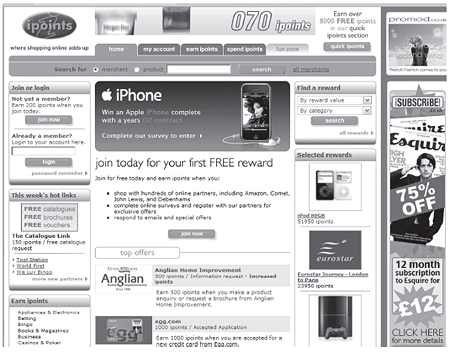
Figure 9.4: www.ipoints.co.uk website
Customer clubs
Customer clubs have been established by many organizations. A customer club can be defi ned as follows:
A customer club is a company-run membership organization that offers a range of value-adding benefits exclusively to members. The initial costs of establishing a club can be quite high, but thereafter most clubs are expected to cover their operating expenses and, preferably, return a profit. Research suggests that customer clubs are successful at promoting customer retention.
To become a member and obtain benefits, clubs require customers to register. With these personal details, the company is able to begin and services for them. Clubs can only succeed if members experience benefi ts they value. Club managers can assemble and offer a range of value-adding services and products that, given the availability of customer data, can be personalized to segment or individual level. Among the more common benefi ts of club membership are access to memberonly products and services, alerts about upcoming new and improved products, discounts, magazines and special offers. For example, IKEA FAMILY, the home furnishing retailer's club, offers members discounts on selected IKEA products, a free home furnishing magazine quarterly, news updates via e-mail and discounts on exclusive IKEA FAMILY products. There are a huge number of customer clubs. One report estimates that there are ' several hundreds ' in Germany alone. 26 B2C clubs include:
- Swatch the Club (see www.swatch.com )
- The Pampers Parenting Institute (see http://us.pampers.com /en_ US/ppi.do)
- The Harley Owners' Group (HOG) (see http://www.harley-davidson. com/wcm/Content/Pages/HOG/hog_selector.jsp?locale en_US )
- The Volkswagen Club (see http://www.vw-club.de/ ).
There are over a million paid-up members of the Harley Owners' Group (see Figure 9.5 ), which was established in 1983. They choose from two levels of membership, full and associate, and a variable membership length, from one year to lifetime. Among the many benefi ts are roadside assistance, a membership manual, a touring handbook, a dedicated website, magazines, a mileage programme, a selection of pins and patches, membership in over 1000 chapters, invitations to events and rallies, and a lot more.

Figure 9.5: Harley Owner's Group
Sales promotions
Whereas loyalty schemes and clubs are relatively durable, sales promotions offer only temporary enhancements to customer value. Sales promotions, as we saw in the last chapter can also be used for customer acquisition. Retention-oriented sales promotions encourage the customer to repeat purchase, so the form they take is different. Here are some examples.
- In-pack or on-pack voucher: customers buy the product and receive a voucher entitling them to a discount off one or more additional purchases.
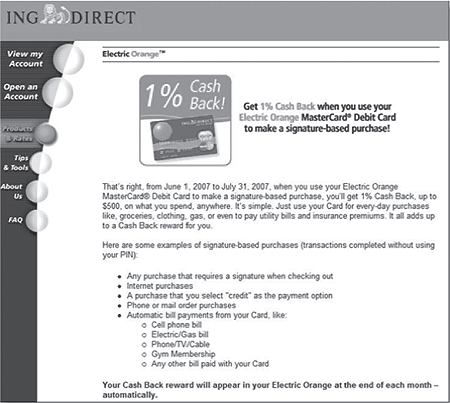
Figure 9.6: Cash-back sales promotion
- Rebate or cash back: rebates are refunds that the customer receives after purchase. The value of the rebate can be adjusted in line with the quantity purchased, in order to reward customers who meet high volume targets.
- Patronage awards: customers collect proofs of purchase, such as store receipts or barcodes from packaging, which are surrendered for cash or gifts. The greater the volume purchased the bigger the award.
- Free premium for continuous purchase: the customer collects several proofs of purchase and mails them in, or surrenders them at retail outlets to obtain a free gift. Sometimes the gift might be part of a collectable series. For example, a manufacturer of preserves and jams developed a range of collectable enamel badges. Customers collected proofs of purchase and mailed them in to receive a badge. There were 20 different badges in the series. This promotion was so popular that a secondary market was established so that collectors could trade and swap badges to obtain the full set.
- Collection schemes: these are long-running schemes where the customer collects items with every purchase. Kellogg's ran a promotion in which they inserted picture cards of carefully chosen sports stars into packets of cereals. Customers didn't know which card they had until they bought and opened the pack. These became collectable items.
- Self-liquidating premium: a self-liquidating promotion is one that recovers its own direct costs. Typically, consumers are invited to collect proofs of purchase, and mail them in with a personal cheque or money order. This entitles the customer to buy a product at a discounted premium, such as a camera or gardening equipment. The promoter will have reached a deal with the suppliers of the products to buy in bulk at a highly discounted rate, perhaps on a sale or return basis. Margins earned from the sale of product, plus the value of the cheque or money order cover the costs of running the promotion which, as a consequence, becomes self-liquidating.
Bonding
The next positive customer retention strategy is customer bonding. B2B researchers have identified many different forms of bond between customers and suppliers. These include interpersonal bonds, technology bonds (as in EDI), legal bonds and process bonds. These different forms can be split into two major categories: social and structural.
Social bonds
Social bonds are found in positive interpersonal relationships between people on both sides of the customer-supplier dyad. Positive interpersonal relationships are characterized by high levels of trust and commitment. Successful interpersonal relationships may take time to evolve, as uncertainty and distance are reduced. As the number of episodes linking customer and supplier grow, there is greater opportunity for social bonds to develop. Suppliers should understand that if they act opportunistically or fail to align themselves to customer preferences, trust and confidence will be eroded.
Strong social bonds can emerge between employees in companies having similar sizes, cultures and locations. For example, small and medium-sized businesses generally prefer to do business with similar sized companies, and Japanese companies prefer to do business with other Japanese companies. Geographic bonds emerge when companies in a trading area cooperate to support each other.
Social relationships between buyer and seller can be single or multilevel. A single-level relationship might exist between the supplier's account manager and the customer's procurement officer. The more interpersonal links there are between the dyad, the more resistant the relationship is to breakdown. For example, technical, quality and operations people talk to their equivalents on the other side.
Social bonds characterized by trust generally precede the development of structural bonds. Mutual investments in business relationships serve as structural bonds. These structural bonds can be formally recognized in an alliance or joint venture having legal status. Companies are unlikely to commit resources if there is a low level of trust in the partner's integrity and competence.
Structural bonds
Structural bonds are established when companies and customers commit resources to a relationship. Generally, these resources yield mutual benefits for the participants. For example, a joint customer-supplier quality team can work improving quality compliance, benefi ting both companies. Resources committed to a relationship may or may not be recoverable if the relationship breaks down. For example, investments made in training a customer's operatives are non-returnable. On the other hand, a chilled products manufacturer that has installed refrigerated space at a distributor's warehouse may be able to dismantle and retrieve it if the relationship dissolves.
A key feature of structural bonding is investment in adaptations to suit the other party. Suppliers can adapt any element of the offer – product, process, price and inventory levels, for example – to suit the customer. Customers, on the other hand, also make adaptations. For example, they can adapt their manufacturing processes to accommodate a supplier's product or technology.
Power imbalances in relationships can produce asymmetric adaptations. A major multiple retailer might force adaptations from small suppliers, while making no concessions itself. For example, it could insist on a reduction in product costs, co-branding of point-of-sale material, or even attempt to coerce the supplier not to supply competitors. Different types of structural bond can be identifi ed. All are characterized by an investment of one or both parties in the other:
- Financial: where the seller offers a financial inducement to retain the customer. Insurance companies form financial bonds with customers by offering no-claims discounts, tenure related discounts and multipolicy discounts.
- Legal: when there is a contract or common ownership linking the relational partners.
- Equity: where both parties invest in order to develop an offer for customers. For example, the owners of airports invest in the shells of the duty-free retail outlets. The retailer invests in the internal fixtures and fittings.
- Knowledge-based: when each party grows to know and understand the other's processes and structures, strengths and weaknesses.
- Technological: when the technologies of the relational partners are aligned, for example, with EDI, just-in-time logistics and manufacturing.
- Process: when processes of the two organizations are aligned. For example, the quality assurance programme on the supplier side and the quality inspection programme on the customer side. Some suppliers manage inventory levels for their customers, ensuring inventory levels are optimized. This is known as vendor managed inventory (VMI). The chemicals company, Solvay Interox, uses telemetry systems to perform VMI for its customers.
- Values-based: some companies are renowned for their strong values. Co-operative Bank is known for its pro-environment, ethical stance. It bonds closely with other companies, such as investment houses, that adopt the same position. It refuses to invest in companies that have poor environmental records.
- Geographic: these bonds exist when companies in a trading area (street, city region or country) create a buyer–seller–referral network that supports all members of their group. In the UK, retailers in downtown Leamington Spa have combated out of town developments by creating a loyalty programme in which customers can collect and redeem loyalty credits at any member store.
- Project: when the partners are engaged in some special activity outside of their normal commercial arrangements, for example, a new product development project. There may be an exchange of resources to enable the desired outcome to be achieved, for example, an exchange of engineers and technologists between the companies.
- Multi-product: when a customer buys several products from a supplier, the bond is more difficult to break. There are economies for customers when they deal with fewer suppliers. When a relationship with a supplier of several products is dissolved, the customer may incur significant money, search and psychic costs in identifying one or more replacements. Further, the level of perceived risk attached to a new relationship may become uncomfortable.
Social bonds are generally easier to break than structural bonds. Structural bonds link organizations. Social bonds link people. If the account manager and procurement offi cer do not grow to trust each other, they may fall out, but this is unlikely to bring down a joint venture.
Build customer engagement
The final positive strategy for building customer retention is to build customer engagement. Various studies have indicated that customer satisfaction is not enough to ensure customer longevity. For example, Reichheld reports that 65 to 85 percent of recently defected customers claimed to be satisfi ed with their previous suppliers. Another study reports that one in ten customers who said they were completely satisfied, scoring ten out of ten on a customer satisfaction scale, defected to a rival brand the following year. Having satisfi ed customers is, increasingly, no more than a basic requirement of being in the game.
Highly engaged customers have levels of emotional or rational attachment or commitment to a brand, experience or organization that are so strong that they are highly resistant to competitive influence. The terms engagement, attachment and commitment tend to be used interchangeably to describe this phenomenon. The topic of customer engagement was introduced in Chapter 6.
Continue to the next section: Understanding customer commitment
Download Chapter 9, Managing the customer lifecycle: customer retention and development
Read other excerpts and download more sample chapters from our CRM and call center bookshelf





